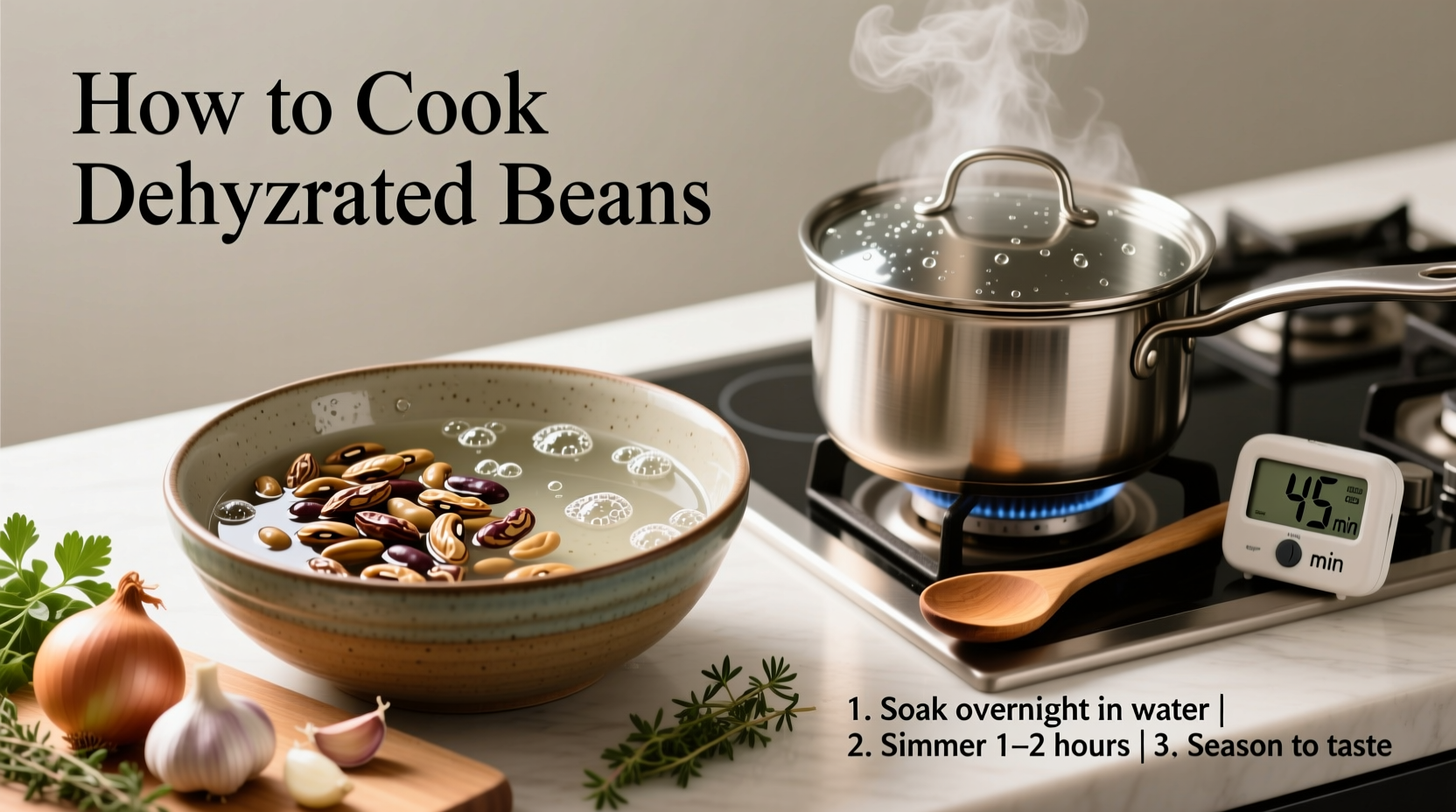Discover the foolproof method to transform rock-hard dehydrated beans into creamy, flavorful ingredients for soups, stews, and salads. Whether you're meal prepping, camping, or building emergency food supplies, this guide delivers restaurant-quality results with precise timing and critical safety steps most guides overlook.
Why Proper Bean Preparation Matters
Dehydrated beans contain phytohaemagglutinin, a natural toxin that causes severe gastrointestinal distress if not properly neutralized. The FDA Food Code mandates boiling beans for at least 10 minutes to destroy this compound. Skipping this step risks food poisoning with symptoms appearing 1-3 hours after consumption.
Essential Equipment Checklist
- Large pot with tight-fitting lid (3-quart minimum)
- Colander for thorough rinsing
- Measuring cups and spoons
- Timer (critical for safety)
- Wooden spoon for gentle stirring
The 3-Step Cooking Process
Step 1: Strategic Rehydration
Proper soaking removes oligosaccharides that cause digestive discomfort while preparing beans for even cooking. Two proven methods exist:
| Method | Water Ratio | Time Required | Best For |
|---|---|---|---|
| Traditional Cold Soak | 3 cups water per 1 cup beans | 8-12 hours | Most bean varieties, especially larger types |
| Hot Quick Soak | 10 cups water per 1 cup beans | 1 hour active time | Emergency preparation, time-sensitive cooking |
Based on National Center for Home Food Preservation guidelines, the hot soak method reduces cooking time by 25% while maintaining texture integrity. Always discard soaking water - it contains released compounds that cause gas.
Step 2: Precision Cooking
After thorough rinsing, combine beans with fresh water using a 1:2 bean-to-water ratio. Critical steps:
- Bring to rapid boil for exactly 10 minutes (destroys toxins)
- Reduce heat to maintain gentle simmer (bubbles barely breaking surface)
- Add salt only after beans are tender (premature salting toughens skins)
- Test for doneness starting at 45 minutes (softer beans cook faster)
Step 3: Flavor Enhancement
Add aromatic elements during the last 30 minutes of cooking:
- Bay leaves reduce gas production (1 leaf per pound of beans)
- Kombu seaweed adds minerals and softens texture
- Onion and garlic boost flavor complexity
- Acidic elements (tomatoes, vinegar) only after full tenderness
Cooking Method Comparison
Choose your method based on available time and equipment:
| Method | Total Time | Water Ratio | Texture Result | Best Bean Types |
|---|---|---|---|---|
| Stovetop (soaked) | 1.5-2 hours | 1:2 | Creamy interior, intact skins | All varieties |
| Pressure Cooker (soaked) | 25-35 minutes | 1:1.5 | Uniform tenderness | Black, pinto, kidney |
| Slow Cooker (soaked) | 4-6 hours | 1:2.5 | Melts-in-mouth softness | Cannellini, navy |
| No-Soak Method | 2-3 hours | 1:3 | Slightly tougher skins | Lentils, split peas |
Critical Safety Boundaries
Never use these risky practices with dehydrated beans:
- Slow cooker without pre-boiling: Temperatures stay in danger zone (40°-140°F) too long
- Adding acid too early: Prevents softening and may increase toxin stability
- Insufficient boiling time: Under 10 minutes fails to neutralize phytohaemagglutinin
- Reusing soaking water: Contains released oligosaccharides causing digestive issues
Troubleshooting Common Issues
Problem: Beans remain hard after cooking
Solution: Check water hardness - minerals interfere with softening. Add 1/4 teaspoon baking soda per pound of beans to soften skins.
Problem: Excessive foaming during boiling
Solution: Skim foam regularly during first 15 minutes to remove impurities. Add a spoonful of oil to reduce foaming.
Problem: Mushy texture
Solution: Overcooking or premature salt addition. Start checking tenderness 15 minutes earlier next time.
Storage Guidelines
Cooked beans keep for 5 days refrigerated in their cooking liquid. For longer storage:
- Freeze in 1.5 cup portions (equivalent to one 15oz can)
- Use airtight containers with 1/2 inch headspace
- Label with date and bean type
- Consume within 6 months for best quality
Advanced Techniques for Perfect Results
Texture control: Add 1 teaspoon vinegar during last 15 minutes for firmer beans ideal for salads. For creamier beans in soups, add 1/4 teaspoon baking soda to cooking water.
Flavor infusion: Replace 25% of cooking water with vegetable broth. Add smoked paprika or chipotle powder for depth without meat.
Time-saving hack: Freeze soaked-but-uncoked beans for up to 3 months. When ready to cook, thaw overnight then proceed with boiling step.











 浙公网安备
33010002000092号
浙公网安备
33010002000092号 浙B2-20120091-4
浙B2-20120091-4